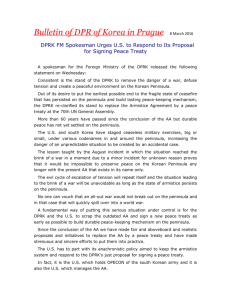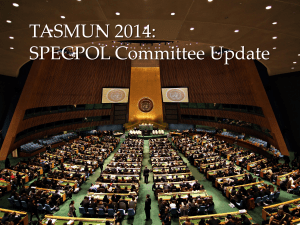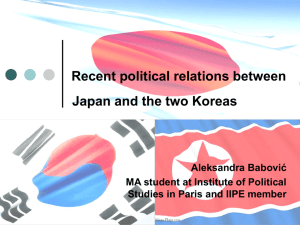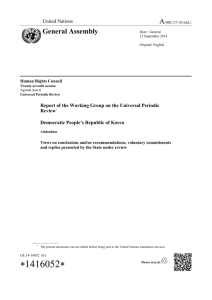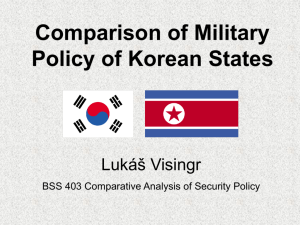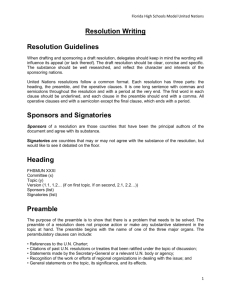AGREED FRAMEWORK BETWEEN THE UNITED STATES OF AMERICA
advertisement
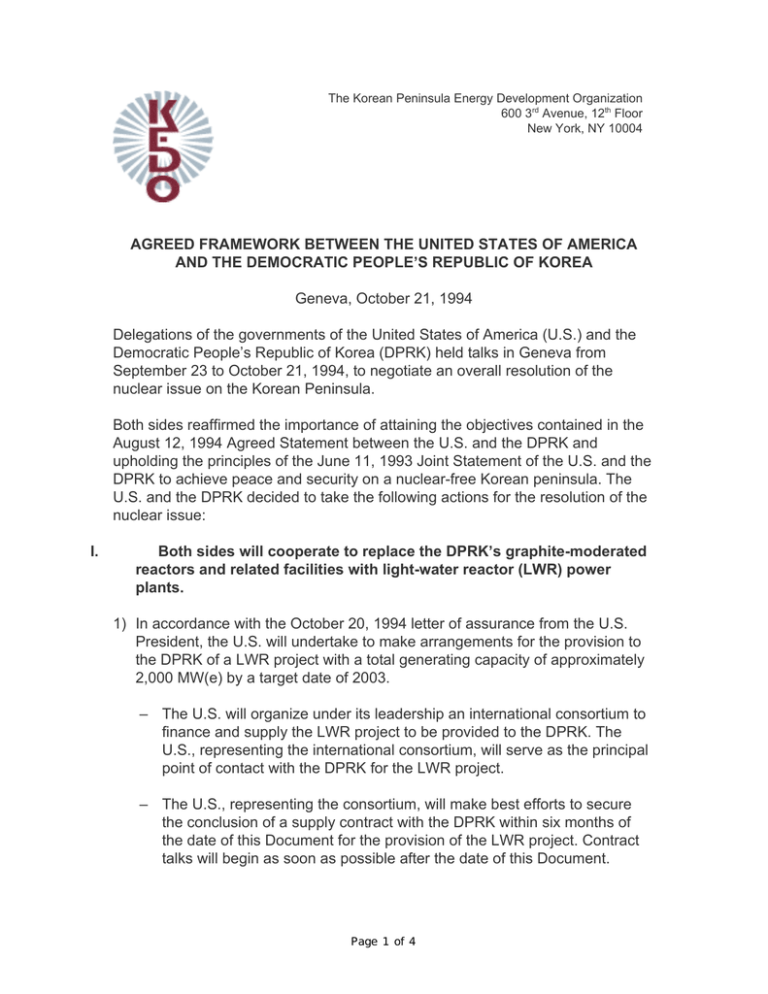
The Korean Peninsula Energy Development Organization 600 3rd Avenue, 12th Floor New York, NY 10004 AGREED FRAMEWORK BETWEEN THE UNITED STATES OF AMERICA AND THE DEMOCRATIC PEOPLE’S REPUBLIC OF KOREA Geneva, October 21, 1994 Delegations of the governments of the United States of America (U.S.) and the Democratic People’s Republic of Korea (DPRK) held talks in Geneva from September 23 to October 21, 1994, to negotiate an overall resolution of the nuclear issue on the Korean Peninsula. Both sides reaffirmed the importance of attaining the objectives contained in the August 12, 1994 Agreed Statement between the U.S. and the DPRK and upholding the principles of the June 11, 1993 Joint Statement of the U.S. and the DPRK to achieve peace and security on a nuclear-free Korean peninsula. The U.S. and the DPRK decided to take the following actions for the resolution of the nuclear issue: I. Both sides will cooperate to replace the DPRK’s graphite-moderated reactors and related facilities with light-water reactor (LWR) power plants. 1) In accordance with the October 20, 1994 letter of assurance from the U.S. President, the U.S. will undertake to make arrangements for the provision to the DPRK of a LWR project with a total generating capacity of approximately 2,000 MW(e) by a target date of 2003. – The U.S. will organize under its leadership an international consortium to finance and supply the LWR project to be provided to the DPRK. The U.S., representing the international consortium, will serve as the principal point of contact with the DPRK for the LWR project. – The U.S., representing the consortium, will make best efforts to secure the conclusion of a supply contract with the DPRK within six months of the date of this Document for the provision of the LWR project. Contract talks will begin as soon as possible after the date of this Document. Page 1 of 4 – As necessary, the U.S. and the DPRK will conclude a bilateral agreement for cooperation in the field of peaceful uses of nuclear energy. 2) In accordance with the October 20, 1994 letter of assurance from the U.S. President, the U.S., representing the consortium, will make arrangements to offset the energy foregone due to the freeze of the DPRK’s graphitemoderated reactors and related facilities, pending completion of the first LWR unit. – Alternative energy will be provided in the form of heavy oil for heating and electricity production. – Deliveries of heavy oil will begin within three months of the date of this Document and will reach a rate of 500,000 tons annually, in accordance with an agreed schedule of deliveries. 3) Upon receipt of U.S. assurances for the provision of LWR’s and for arrangements for interim energy alternatives, the DPRK will freeze its graphite-moderated reactors and related facilities and will eventually dismantle these reactors and related facilities. – The freeze on the DPRK’s graphite-moderated reactors and related facilities will be fully implemented within one month of the date of this Document. During this one-month period, and throughout the freeze, the International Atomic Energy Agency (IAEA) will be allowed to monitor this freeze, and the DPRK will provide full cooperation to the IAEA for this purpose. – Dismantlement of the DPRK’s graphite-moderated reactors and related facilities will be completed when the LWR project is completed. – The U.S. and the DPRK will cooperate in finding a method to store safely the spent fuel from the 5 MW(e) experimental reactor during the construction of the LWR project, and to dispose of the fuel in a safe manner that does not involve reprocessing in the DPRK. 4) As soon as possible after the date of this document U.S. and DPRK experts will hold two sets of experts talks. – At one set of talks, experts will discuss issues related to alternative energy and the replacement of the graphite-moderated reactor program with the LWR project. Page 2 of 4 – At the other set of talks, experts will discuss specific arrangements for spent fuel storage and ultimate disposition. II. The two sides will move toward full normalization of political and economic relations. 1) Within three months of the date of this Document, both sides will reduce barriers to trade and investment, including restrictions on telecommunications services and financial transactions. 2) Each side will open a liaison office in the other’s capital following resolution of consular and other technical issues through expert level discussions. 3) As progress is made on issues of concern to each side, the U.S. and the DPRK will upgrade bilateral relations to the Ambassadorial level. III. Both sides will work together for peace and security on a nuclearfree Korean peninsula. 1) The U.S. will provide formal assurances to the DPRK, against the threat or use of nuclear weapons by the U.S. 2) The DPRK will consistently take steps to implement the North-South Joint Declaration on the Denuclearization of the Korean Peninsula. 3) The DPRK will engage in North-South dialogue, as this Agreed Framework will help create an atmosphere that promotes such dialogue. IV. Both sides will work together to strengthen the international nuclear non proliferation regime. 1) The DPRK will remain a party to the Treaty on the Non-Proliferation of Nuclear Weapons (NPT) and will allow implementation of its safeguards agreement under the Treaty. 2) Upon conclusion of the supply contract for the provision of the LWR project, ad hoc and routine inspections will resume under the DPRK’s safeguards agreement with the IAEA with respect to the facilities not subject to the freeze. Pending conclusion of the supply contract, inspections required by the IAEA for the continuity of safeguards will continue at the facilities not subject to the freeze. Page 3 of 4 3) When a significant portion of the LWR project is completed, but before delivery of key nuclear components, the DPRK will come into full compliance with its safeguards agreement with the IAEA (INFCIRC/403), including taking all steps that may be deemed necessary by the IAEA, following consultations with the Agency with regard to verifying the accuracy and completeness of the DPRK’s initial report on all nuclear material in the DPRK. __________________________ Robert L. Gallucci Head of Delegation of the United States of America, Ambassador at Large of the United States of America _________________________ Kang Sok Ju Head of the Delegation of the Democratic People's Republic of Korea, First Vice-Minister of Foreign Affairs of the Democratic People's Republic of Korea Page 4 of 4


